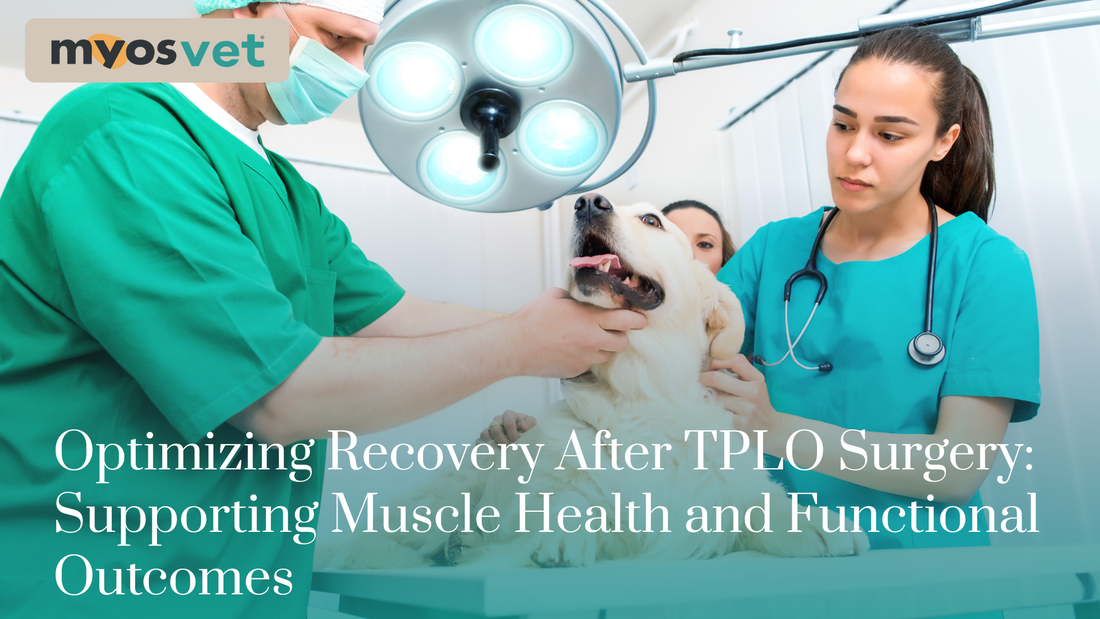
Optimizing Recovery After TPLO Surgery: Supporting Muscle Health and Functional Outcomes
Share
Tibial Plateau Leveling Osteotomy (TPLO) remains one of the most effective and commonly performed procedures to stabilize the stifle following cranial cruciate ligament (CCL) rupture. While the surgical outcomes are generally excellent, recovery can be variable and is often influenced by post-operative management. For veterinary professionals, ensuring optimal recovery involves a multifaceted approach that supports not just bone healing, but also muscle preservation, joint stability, and inflammation control.
The Challenge: Post-Operative Muscle Atrophy
Muscle atrophy is one of the most common and significant complications during TPLO recovery. Studies have shown that dogs can lose up to 30% of quadriceps and hamstring muscle mass in the affected limb within just a few weeks of restricted activity (Millis & Levine, 2014). This loss of muscle strength not only delays return to function but also increases stress on the surgical site and contralateral limb, predisposing to future injury.
Phase-Specific Recovery Strategies
1. Immediate Post-Operative Phase (0–2 weeks)
The initial focus should be on controlling pain, swelling, and inflammation while preventing excessive stress on the osteotomy site. Passive range of motion (PROM) exercises, cold compression therapy, and laser therapy can be beneficial when introduced appropriately. Anti-inflammatory medications, either NSAIDs or adjunctive agents such as omega-3 fatty acids, help modulate the inflammatory response and support healing (Franklin et al., 2017).
2. Early Rehabilitation (2–6 weeks)
Once weight-bearing begins, gradual muscle reactivation is key. Modalities such as underwater treadmill therapy and controlled leash walks help encourage symmetrical gait and reduce compensatory loading. Low-impact exercises improve joint nutrition, muscle perfusion, and proprioception.
At this stage, nutrition plays a crucial role. High-quality dietary protein and targeted nutritional support that includes natural bioactive compounds may help slow muscle degradation. Fortetropin®, the active ingredient in MYOS Canine Muscle Formula, has been shown in peer-reviewed studies to reduce serum myostatin levels—a key regulator of muscle growth inhibition—and to promote muscle protein synthesis (White et al., 2019). By supporting muscle retention, such interventions can help accelerate recovery and functional return.
3. Strengthening and Conditioning (6–12+ weeks)
As bone healing progresses, increasing load-bearing and functional exercises helps rebuild muscle mass and endurance. Strengthening protocols should focus on concentric and eccentric control through hill walking, sit-to-stands, and balance work. Veterinary teams can tailor rehabilitation intensity based on follow-up radiographs and limb use assessments.
Integrating nutritional strategies that promote lean muscle gain can further enhance outcomes. A balanced diet with controlled caloric intake and adequate amino acid availability supports muscle recovery without promoting weight gain—an important factor in maintaining long-term joint health.
Inflammation Control and Immune Support
Surgical stress and reduced mobility can create a pro-inflammatory environment that hinders recovery. Nutraceuticals such as omega-3 fatty acids, vitamin E, and compounds that reduce oxidative stress can support the healing process. Fortetropin has demonstrated anti-inflammatory properties by modulating cytokine activity and supporting cellular repair pathways (Herbst et al., 2020), making it a valuable adjunct in managing post-surgical inflammation.
Communication and Compliance
For successful recovery, clear communication with pet owners is as critical as the clinical interventions themselves. Compliance with rehabilitation and nutritional protocols significantly impacts recovery speed and quality of outcome. Providing owners with clear timelines, structured exercise plans, and nutritional recommendations can improve adherence and reduce complications.
Looking Ahead: Whole-Body Wellness Beyond the Surgery
While the immediate goal after TPLO is stifle stabilization and return to mobility, long-term outcomes depend on comprehensive support for muscle, joint, and metabolic health. Addressing sarcopenia, maintaining optimal body condition, and supporting healthy muscle turnover through diet and targeted supplementation can improve longevity and quality of life post-surgery.
Conclusion
TPLO surgery provides mechanical stability, but recovery depends heavily on how well we support soft tissue and muscle health post-operatively. A combination of pain control, structured rehabilitation, anti-inflammatory support, and nutritional strategies that target muscle preservation—such as Fortetropin—can help veterinary professionals optimize patient outcomes and accelerate return to normal function.
